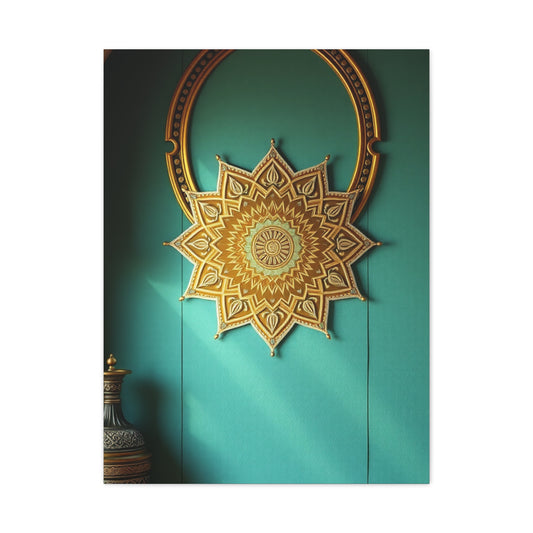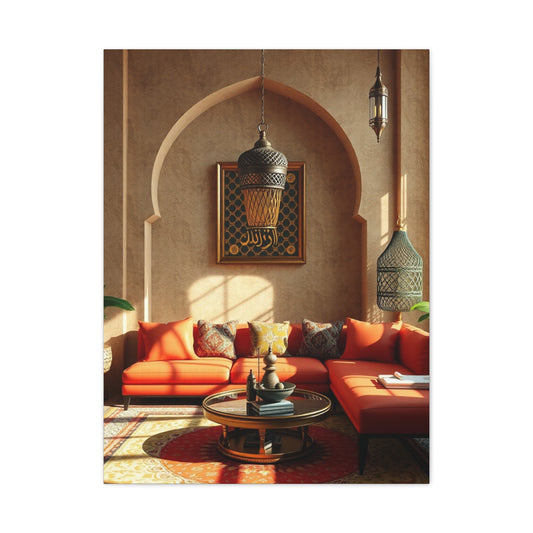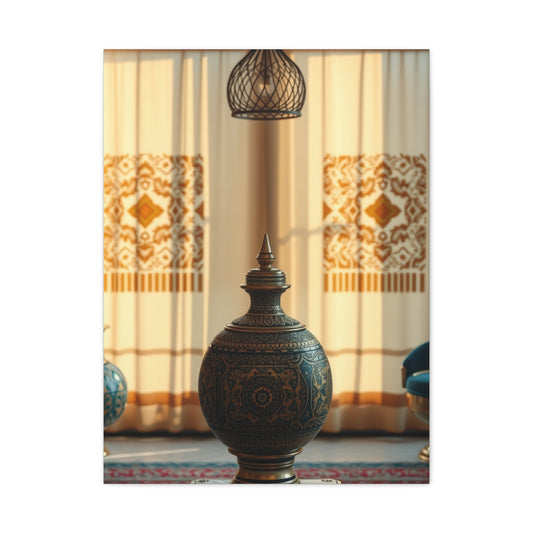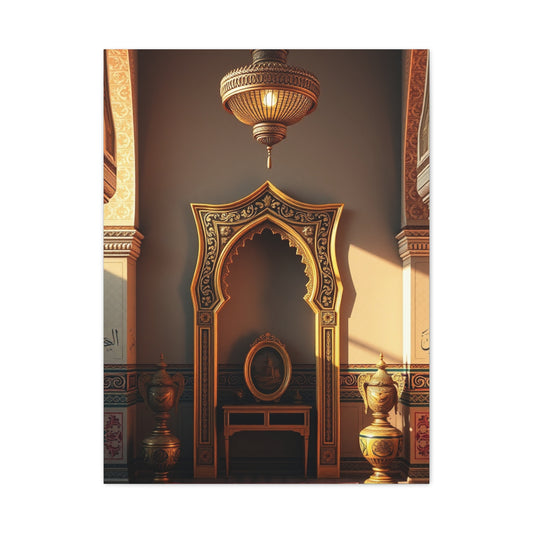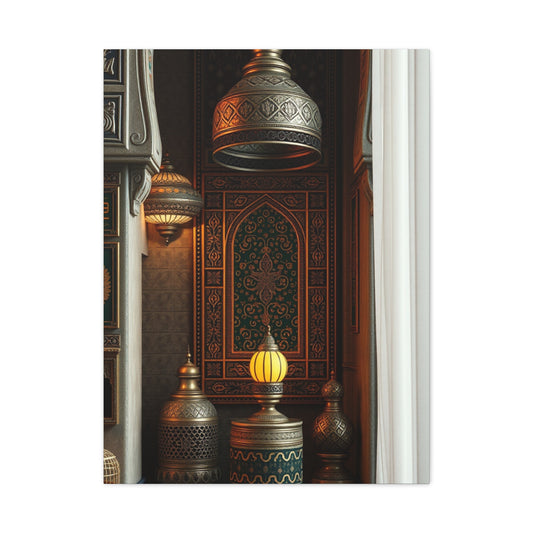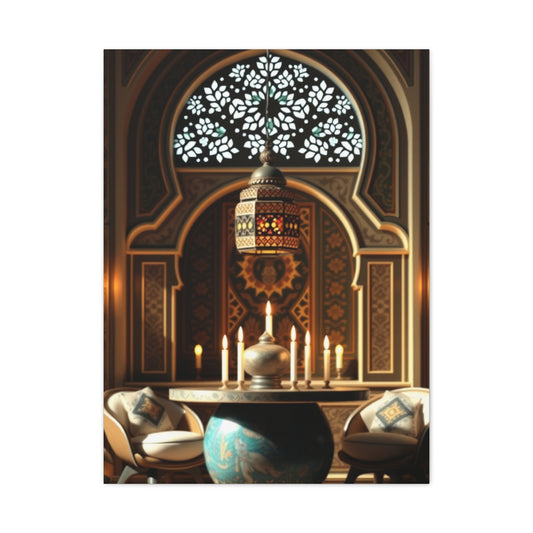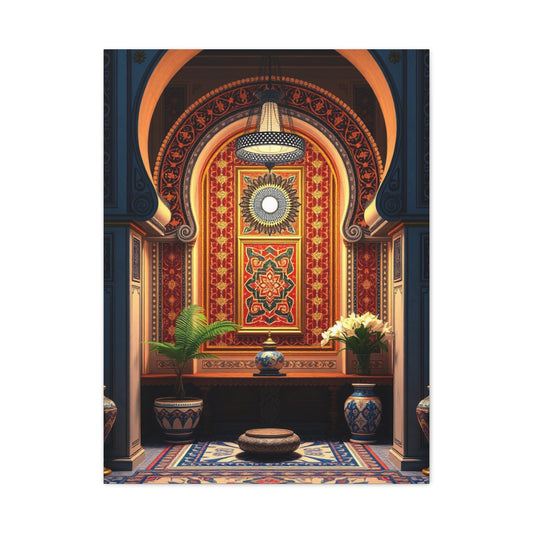Middle Eastern Elegance Made Simple: Wall Design Ideas for Every Home
Arabic wall design instantly infuses a space with history, elegance, and depth. It is more than mere decoration; it is a legacy of centuries-old craftsmanship expressed through geometry, symmetry, and poetic ornamentation. From palatial mosques to contemporary penthouses, these patterns evoke cultural richness while adapting seamlessly to modern tastes. The appeal lies in the way a wall becomes not just a backdrop, but a narrative canvas—telling stories through color, line, and form.
For homeowners balancing busy lives yet desiring unique interiors, this design language offers both flexibility and timelessness. A single accent wall can stand as a cultural statement, while full-room installations create immersive environments that celebrate tradition while remaining contemporary. This versatility is why Arabic wall design has transcended geography, inspiring designers in Europe, North America, and Asia just as much as in the Middle East.
Understanding its essence requires an exploration of heritage, symbolism, and practical application. By uncovering its historical background, core principles, categories, and modern uses, you will find not only inspiration but also actionable ideas to incorporate these motifs into your own living space.
Historical Background
The roots of Arabic wall design stretch back over a thousand years, flourishing during the Islamic Golden Age. Scholars, artisans, and architects sought to express spirituality without figural imagery, turning instead to geometry, calligraphy, and botanical stylization. These designs were not arbitrary ornamentation; they reflected deep philosophical and mathematical principles.
From the Alhambra in Granada with its mesmerizing tilework to Cairo’s Mamluk-era mosques adorned with marble inlays, walls became sacred canvases. The concept of infinity, repetition, and divine order manifested in tessellations and arabesques. Craftsmen meticulously arranged tiles, plaster carvings, and wood latticework to reflect cosmic harmony. This tradition later spread across empires—Ottoman, Persian, and Mughal—each contributing regional nuances yet preserving shared foundations.
In modern times, these motifs retain their resonance. They are no longer confined to religious or royal settings but are reinterpreted in residences, offices, and hospitality spaces. By drawing upon centuries of visual philosophy, contemporary designers honor the past while exploring new material technologies and applications.
Core Concepts and Foundations
The essence of Arabic wall design lies in intentional repetition and balance. Symmetry is not simply an aesthetic choice but an articulation of order and unity. Motifs often follow strict geometric logic: interlocking polygons, radiating stars, and infinite lattices that symbolize continuity.
Alongside geometry, arabesque floral patterns evoke growth, vitality, and natural beauty. Vines, leaves, and blossoms are abstracted into rhythmic motifs that can be scaled up or down depending on context. Calligraphy, meanwhile, elevates language into visual poetry. Quranic verses, poetry, or simple blessings flow across walls with fluid elegance, blending text with art.
Color is another foundation. Jewel tones dominate, balanced with neutrals or metallics. Blue often symbolizes spirituality and tranquility, green prosperity, and gold divine illumination. Modern interpretations experiment with muted palettes, yet the interplay of contrast remains vital.
These foundations are not rigid rules but guiding principles. The beauty lies in adaptability, allowing homeowners to select motifs and colors that align with their personal style while retaining authenticity.
Types and Categories
Arabic wall design can be divided into several key categories, each offering a distinctive visual impact.
Geometric Lattices
Among the most recognizable features are geometric tessellations. Repeating polygons, stars, and interwoven lines form complex yet harmonious grids. These lattices can cover entire walls or function as subtle borders, ideal for foyers, living rooms, or study areas.
Arabesque Floral Motifs
Flowing vegetal forms bring organic softness to spaces. These designs are versatile, ranging from large-scale murals that resemble garden walls to delicate friezes framing windows or arches. They are particularly effective in bedrooms or lounges, where a sense of tranquility is desired.
Calligraphy-Based Designs
Inscribed verses or aphorisms add layers of meaning. These may be hand-painted, stenciled, or created with vinyl decals. Calligraphic panels make powerful focal points, often placed above entryways, mantels, or prayer niches.
Mashrabiya-Inspired Patterns
Lattice screens traditionally carved from wood are now replicated in gypsum, PVC, or metal. Applied as wall panels, they serve both decorative and functional purposes—concealing lighting, enhancing privacy, or adding texture.
Mosaic and Tile Work
Ceramic or stone mosaics remain an enduring medium. Their glossy finishes and durability make them ideal for kitchens, bathrooms, and outdoor courtyards. Modern tiles often use recycled materials or eco-friendly glazes, aligning heritage with sustainability.
Practical Applications
The application of Arabic wall design in modern homes extends far beyond palatial installations. Homeowners today seek both grandeur and practicality, often within compact urban settings.
Accent walls are the most accessible entry point. A single surface adorned with geometric wallpaper, carved panels, or stenciled motifs can define an entire room. For apartments, peel-and-stick options or removable decals provide renter-friendly solutions without long-term commitment.
In larger residences, designs may extend across entire rooms or courtyards. Gypsum panels with hidden LED lighting transform walls into luminous features. Bathrooms benefit from waterproof mosaics that add both color and texture. Kitchens, often overlooked, can be elevated with patterned tile backsplashes blending function with artistry.
Even compact spaces like entryways or hallways can become memorable with narrow friezes, calligraphic borders, or lattice-inspired wainscoting. These subtle applications demonstrate that grandeur does not require vast square footage but rather thoughtful placement.
For those balancing aesthetics with practicality, modern manufacturers now offer eco-friendly, mold-resistant, and washable finishes. Such products ensure longevity, especially in high-traffic areas or humid environments. Maintenance is simplified without sacrificing elegance, allowing busy homeowners to enjoy a lasting impact with minimal upkeep.
Step-by-Step Guides to Transformative Wall Art
Wall art has always been a reflection of culture, creativity, and individuality. Over the past decade, it has transcended its role as a simple decoration to become an essential element of interior design, shaping how spaces are experienced and remembered. Whether through contemporary canvases, mural painting, or innovative mixed media, wall art adapts to shifting lifestyles, technologies, and aesthetic preferences. To explore its relevance today, it is helpful to look closely at step-by-step approaches for integrating these evolving ideas into modern interiors.
Identifying Personal Style and Direction
The first step in adopting wall art is clarifying personal direction. Homeowners must decide whether they lean toward minimalism, maximalism, or a fusion of both. For some, abstract pieces resonate, while others prefer nature-inspired murals, photographic reproductions, or cultural motifs. Journaling inspirations, browsing galleries, or curating digital mood boards can help crystallize preferences before making large-scale design commitments.
Assessing Spatial Qualities
Walls are not blank canvases but architectural frameworks with proportions, textures, and light conditions that dictate what art will thrive. Small apartments may require scaled-down works, while expansive lofts invite oversized murals or installations. Lighting is equally critical; natural light enhances organic textures, while artificial illumination highlights bold hues or metallic finishes. By assessing these qualities, homeowners ensure that chosen wall art complements rather than overwhelms the space.
Selecting Media and Materials
Contemporary wall art encompasses a vast range of media. Traditional framed canvases remain popular, but textile hangings, digital prints, sculptural panels, and mixed-media collages offer equally compelling choices. Sustainable materials such as bamboo, reclaimed wood, and recycled metals have entered the mainstream, reflecting a broader societal emphasis on environmental consciousness. Exploring these options step by step ensures that final selections align with both visual goals and ethical values.
Experimenting with Layouts and Configurations
Once selections are made, experimenting with placement and arrangement becomes essential. Gallery walls, symmetrical arrangements, and asymmetrical clusters all evoke different emotions. Templates or digital visualization tools allow experimentation without permanent commitment. A balanced arrangement ensures that each piece contributes to the overall narrative rather than competing for attention.
Installation and Execution
The final step involves installation. Precision matters: frames must be aligned, murals painted with steady craftsmanship, and wall sculptures secured safely. Attention to detail during this stage transforms preparation into polished execution, ensuring that the investment in wall art translates into long-term enjoyment and harmony.
Emerging Styles in Contemporary Wall Art
Trends in wall art evolve in response to cultural movements, technological innovations, and shifting lifestyles. Several distinct styles are defining interiors today, each offering homeowners unique avenues for expression.
Minimalist and Monochrome Art
Minimalism emphasizes restraint and simplicity, favoring monochrome palettes and geometric forms. These works highlight space itself, using subtle contrasts to evoke calmness and clarity. In urban apartments, minimalist wall art complements streamlined furniture, creating sanctuaries of quiet amid metropolitan bustle.
Nature-Inspired and Botanical Murals
Murals inspired by forests, oceans, and botanical elements bring biophilic design indoors. These expansive works transform walls into immersive landscapes, blurring the boundary between interior and exterior. From lush tropical leaves to delicate watercolor florals, nature-themed murals offer both vibrancy and tranquility, aligning with the human desire to remain connected to the natural world.
Textured and Sculptural Surfaces
A rising trend is three-dimensional wall art, which introduces tactile experiences into interiors. Carved wood panels, ceramic reliefs, and fabric-based installations interact with light and shadow, creating dynamic visual shifts throughout the day. Such pieces encourage touch and exploration, enriching the sensory dimension of home environments.
Digital and Interactive Art
With the advent of projection mapping and LED technologies, walls can now become interactive canvases. Digital installations shift colors, patterns, or imagery in response to sound or movement, offering ever-changing atmospheres. These innovations appeal to tech-savvy homeowners seeking personalization and versatility in their living spaces.
Cultural and Heritage-Inspired Works
Globalization has fueled renewed interest in heritage-inspired wall art. Arabic patterns, African textiles, and East Asian ink paintings are reinterpreted through modern media, celebrating cultural identity while appealing to cosmopolitan sensibilities. Such works carry narratives of ancestry and craftsmanship, turning homes into repositories of global artistry.
Practical Approaches for Homeowners
Adopting emerging wall art does not require extensive renovations or limitless budgets. Step-by-step, homeowners can create compelling visual experiences with thoughtful planning and modest investments.
Begin with accent pieces in high-traffic areas such as living rooms or entryways, where they are most likely to spark conversation. Experiment with temporary solutions like removable wallpaper, vinyl decals, or modular panels, which allow flexibility for evolving tastes. Invest in lighting to highlight chosen works, as a well-placed spotlight can elevate even modest pieces into focal points.
For renters, wall art solutions must be reversible. Adhesive hooks, lightweight canvases, and peel-and-stick murals offer impactful results without risking damage to walls. In contrast, homeowners with long-term residences can explore permanent methods such as built-in murals, mosaic installations, or integrated panels.
Challenges and Solutions in Modern Wall Art
While emerging trends offer boundless inspiration, they also present challenges. Oversaturation is one risk; filling every wall with bold art can lead to visual fatigue. The solution lies in curatorial restraint—balancing space with decorated surfaces to maintain harmony.
Another challenge is the budget. Original artworks, particularly large-scale or bespoke pieces, may be financially prohibitive. Limited-edition prints, student artworks, or collaborations with emerging artists offer affordable alternatives without sacrificing uniqueness.
Sustainability also remains a concern. Some synthetic materials used in wall art may release harmful emissions. Choosing eco-certified paints, recycled canvases, and non-toxic adhesives ensures health and environmental safety.
Finally, maintaining relevance is a subtle challenge. Trends evolve rapidly, and what feels cutting-edge today may appear dated tomorrow. Homeowners can mitigate this by choosing versatile works that transcend trend cycles, blending timeless aesthetics with contemporary influences.
The Future of Wall Art
Looking ahead, the future of wall art is poised to be both dynamic and inclusive. The rise of digital technologies will continue to expand possibilities, enabling customizable, interactive walls that shift with moods or occasions. Artificial intelligence may soon generate personalized murals based on individual preferences, while augmented reality platforms could allow homeowners to preview artworks in their spaces before committing.
Sustainability will play a dominant role. Bio-based pigments, biodegradable panels, and carbon-neutral production methods are expected to define the next generation of wall art materials. Designers and artists alike are recognizing the responsibility to align creative expression with environmental stewardship.
Globalization will further enrich the landscape. Cross-cultural collaborations will fuse motifs, materials, and philosophies from diverse traditions, resulting in eclectic yet harmonious compositions. Homes will increasingly reflect not just individual identities but also collective human heritage.
In parallel, a renewed appreciation for craftsmanship will grow. Hand-painted murals, artisanal weavings, and sculptural ceramics will serve as counterbalances to digital innovations, ensuring that tactile, human-centered artistry remains central in an age of automation.
Expert Recommendations for Homeowners
Design professionals emphasize a layered approach to integrating wall art. Instead of treating it as an afterthought, they suggest envisioning it as an integral component of the design process, influencing color schemes, furniture placement, and lighting decisions. By beginning with wall art, homeowners create cohesive interiors where every element feels interconnected.
Experts also recommend mixing scales and mediums. A large mural paired with smaller framed works or sculptural pieces creates rhythm and variety, preventing monotony. Flexibility is key; modular panels or interchangeable artworks allow homeowners to refresh spaces seasonally or as their tastes evolve.
Finally, experts advise prioritizing authenticity. Whether choosing mass-produced prints or bespoke commissions, selecting works that resonate personally ensures lasting satisfaction. Wall art should not merely impress visitors but inspire those who live with it daily, becoming a source of comfort, joy, and reflection.
Integrating Tradition and Innovation
Wall art has always been a medium through which civilizations articulate their values, aesthetics, and philosophies. Today, it stands at an intersection where ancient traditions converge with modern design sensibilities. This merging of eras demonstrates that walls are more than surfaces; they are repositories of stories, memories, and cultural dialogues. The most powerful spaces are often those where innovation does not eclipse heritage but enhances it.
Traditional motifs, whether geometric, botanical, or narrative, remain timeless because they are grounded in universal human experiences. Their repetition and symmetry speak to a desire for order, balance, and continuity. Yet, contemporary innovation brings these motifs into fresh relevance through technology, sustainable materials, and adaptive design. In practice, this means that a centuries-old lattice pattern might appear in a laser-cut metal partition or that a hand-painted mural could be illuminated with LED backlighting to create depth and vibrancy.
The task for homeowners and designers lies in weaving these threads together with intentionality. Rather than seeing tradition and innovation as opposites, they can be understood as complementary forces shaping the future of interiors.
Emotional Resonance of Wall Art
Beyond aesthetics and craftsmanship, wall art holds emotional resonance that transforms spaces into lived experiences. A mural depicting a botanical landscape may soothe the mind after a long day, while a geometric composition can encourage focus and clarity in a study. Calligraphic pieces, abstract panels, or sculptural installations all carry symbolic meaning, often providing daily inspiration or quiet reminders of identity.
Psychologists studying environmental design emphasize that visual surroundings influence mental well-being. Calm tones and harmonious patterns reduce stress, while vibrant hues and bold strokes stimulate energy. Wall art thus becomes more than decoration; it becomes a silent companion in everyday life, shaping mood and productivity. This intangible impact is what elevates it from accessory to essential design element.
For families, artworks often serve as heirlooms, connecting generations through shared stories. A hand-painted mural in a living room may one day be remembered as the backdrop of childhood memories, infusing the home with emotional continuity. Such connections underscore the power of walls as carriers of personal and collective identity.
The Global Dialogue of Wall Art
One of the most fascinating aspects of modern wall art is its global dialogue. Designers in New York draw inspiration from Moroccan tiles, while homeowners in Tokyo integrate Scandinavian minimalism with calligraphic flourishes. This exchange reflects an interconnected world where influences transcend borders.
Cultural cross-pollination does not dilute authenticity; instead, it enriches the vocabulary of wall art. A living room may combine an Indian block-printed textile with a contemporary abstract canvas, creating an eclectic yet harmonious narrative. Each piece brings its own cultural lineage, yet together they form a cosmopolitan whole that mirrors today’s globalized lifestyles.
This dialogue also fosters appreciation for diversity. By incorporating artworks rooted in different traditions, homeowners participate in a larger celebration of heritage and creativity. The result is not only visually striking but also socially meaningful, as it reflects values of inclusivity and respect.
Sustainability as a Driving Force
The twenty-first century demands a shift in how wall art is conceived, produced, and maintained. Environmental responsibility is no longer optional but essential. As climate concerns rise, homeowners and artists alike are embracing eco-conscious approaches.
Natural pigments, biodegradable canvases, and reclaimed materials are increasingly favored. Murals painted with low-VOC paints contribute to healthier indoor air, while recycled wood panels reduce ecological footprints. Even digital art, though dependent on technology, often minimizes material waste compared to traditional media.
Sustainability extends to durability. High-quality, long-lasting pieces reduce the need for frequent replacements, aligning aesthetics with environmental stewardship. By investing in enduring works, homeowners simultaneously cultivate beauty and responsibility. This alignment ensures that the evolution of wall art contributes positively to both interior environments and the broader planet.
Practical Applications for Modern Homes
While philosophical reflections enrich understanding, practical applications remain central for homeowners navigating busy lives. Wall art does not need to be grandiose to make an impact. Simple yet intentional interventions can reshape the atmosphere of a room.
Accent walls are a practical starting point. A single mural or wallpaper can define a space, whether it is a bedroom, dining area, or entryway. In compact apartments, modular panels or removable decals allow experimentation without permanence. Larger residences, meanwhile, can explore expansive murals, sculptural installations, or tiled surfaces.
Lighting remains an often-overlooked factor. A carefully positioned spotlight or backlit panel can dramatically alter how wall art is perceived. Shadows enhance texture, while illumination deepens color intensity. By pairing art with lighting, homeowners elevate impact without increasing complexity.
Another practical consideration is adaptability. Modular or interchangeable pieces allow spaces to evolve with changing tastes. Homeowners may rotate artworks seasonally or update compositions over time, keeping environments fresh and dynamic. This flexibility ensures that investment in wall art remains relevant for years.
Challenges and Balancing Acts
Despite its transformative potential, wall art presents challenges requiring thoughtful navigation. Overindulgence is a recurring issue; covering every wall with bold designs can overwhelm the senses. The solution lies in restraint, allowing space to balance ornamentation.
Another challenge is authenticity. With mass production, it is easy to adopt designs superficially without understanding their cultural weight. Experts advise selecting works with intention, whether by learning about the artist, the motif’s origin, or the symbolism embedded within. This ensures that art remains meaningful rather than a decorative veneer.
Budget constraints are another practical hurdle. Original or large-scale works may exceed financial capacity. However, limited-edition prints, collaborative pieces, and student art provide affordable entry points while still offering individuality. Creative homeowners may even attempt DIY projects, adding personal authenticity while managing costs.
Maintenance is also essential. Dust, humidity, or sunlight can damage artworks if ignored. Proper care—using pH-neutral cleaners, rotating displays to avoid fading, or applying protective coatings—ensures longevity. Awareness of these challenges transforms ownership from passive enjoyment into active stewardship.
Expert Perspectives on Future Directions
Design experts agree that wall art will continue to evolve alongside cultural, technological, and environmental shifts. Several insights highlight anticipated trajectories.
Architects predict greater integration of art with architectural frameworks. Walls may increasingly feature built-in niches, recessed panels, or digital surfaces designed specifically for artistic display. This integration blurs boundaries between structure and ornament.
Artists emphasize personalization. Commissioned works tailored to individual households will rise in popularity, as homeowners seek pieces that reflect their identities rather than generic trends. Digital platforms already facilitate such collaborations, enabling direct connections between creators and clients across continents.
Sustainability experts anticipate stricter standards for materials, urging greater use of renewable resources and closed-loop production methods. This movement aligns with global priorities, ensuring that creative expression supports ecological health.
Cultural historians foresee continued cross-cultural dialogue, with hybrid forms blending traditions in new ways. This dynamic reflects a world where identity is increasingly multifaceted and where art becomes a bridge between heritage and modernity.
Fusion of Global Inspirations
Wall art today reflects a seamless blending of cultural traditions and modern aesthetics. In living spaces across the world, motifs that once belonged to a single heritage now appear in surprising juxtapositions. A handwoven textile may sit alongside a digital projection, while geometric forms borrowed from Islamic architecture might frame abstract compositions of contemporary artists. This cultural interlacing allows homeowners to shape environments that feel both worldly and personal. The fusion of global inspirations not only adds visual variety but also serves as a testament to the interconnected nature of our age.
The accessibility of digital platforms has accelerated this exchange. Artists from distant corners of the globe showcase their work to audiences who can instantly adapt those ideas into their own interiors. A mural inspired by Andalusian tiles might find itself painted on a loft wall in Toronto, while Scandinavian simplicity may be reimagined in a home in Marrakech. This interplay ensures that wall art will remain dynamic, evolving with each cultural dialogue.
Technological Interventions in Wall Design
Technology has redefined the possibilities for wall art by transforming both production and presentation. Digital printing techniques allow intricate patterns and textures to be reproduced at aa once impossible scale. Homeowners can now commission customized wallpapers or murals that are tailored to their precise dimensions and preferences. Augmented reality applications even enable individuals to preview artworks on their walls before making a final decision, reducing uncertainty in the design process.
Interactive walls represent another frontier. Motion sensors and projection mapping make it possible for artworks to respond to movement or changing light conditions. These innovations blur the distinction between static decor and living installation, offering immersive experiences within the home. While some may fear that technology erodes authenticity, others see it as an extension of creativity, enabling artists to reach new dimensions of expression.
Emotional Depth and Storytelling
A crucial dimension of wall art is its ability to carry narratives. Unlike plain surfaces, walls adorned with symbolic imagery evoke emotions and memories. A hand-painted mural in a child’s bedroom may become part of cherished recollections, while a calligraphic inscription in a study can serve as a daily reminder of wisdom and reflection. In communal areas such as dining rooms or living halls, large-scale artworks often act as conversation starters, weaving social interaction around shared appreciation.
Storytelling through wall art also connects households to broader traditions. A botanical motif may recall ancestral ties to nature, while abstract compositions may resonate with themes of resilience and aspiration. The emotional layers embedded in wall designs transform houses into sanctuaries where personal and cultural histories find visual form.
The Role of Sustainability
Environmental responsibility has become an undeniable concern in modern interior design. The realm of wall art is no exception, with sustainability influencing both material selection and creative philosophy. Eco-friendly paints, biodegradable wallpapers, and reclaimed wood panels are increasingly common. Artists and homeowners alike are drawn to the idea that beauty need not come at the expense of the planet.
Sustainable wall art also emphasizes longevity. Instead of disposable trends, there is a growing appreciation for works that endure through decades, reducing waste and maintaining relevance. This perspective aligns with the traditional notion of craftsmanship, where durability was as important as aesthetics. By investing in long-lasting, environmentally conscious pieces, homeowners cultivate interiors that are both elegant and responsible.
Practical Approaches for Everyday Spaces
While expansive murals and technologically advanced installations capture attention, most homeowners seek practical approaches that balance beauty with feasibility. One effective method is creating accent walls, where a single surface becomes the focal point through bold colors, textures, or designs. This allows artistic expression without overwhelming the room.
Removable decals and modular panels provide flexibility for those hesitant about permanence. Such solutions are particularly useful in urban apartments or rented homes where structural changes are limited. For larger residences, multi-surface projects, layered textures, and sculptural additions can be explored, bringing drama and sophistication into common areas.
Lighting further enhances practical applications. A well-placed light fixture can transform a flat image into a dynamic centerpiece by highlighting textures and casting gentle shadows. For artworks with metallic or reflective surfaces, strategic lighting can create shifting visual effects throughout the day. This attention to illumination transforms modest investments into striking visual experiences.
Overcoming Challenges in Wall Design
Despite the creative possibilities, homeowners often encounter challenges in implementing wall art. One common issue is excess. Over-decorating every wall with vibrant patterns can lead to visual fatigue. The solution lies in balance, where certain surfaces are left intentionally bare to allow artful areas to stand out.
Authenticity poses another challenge. With mass-produced prints flooding the market, the danger of superficial design looms large. Homeowners must carefully select works that hold genuine meaning, whether by supporting local artisans, commissioning original art, or learning the cultural context behind specific motifs. Such intentionality prevents wall art from becoming a hollow trend and ensures it contributes authentically to the household’s narrative.
Budget constraints also demand consideration. Original pieces or large installations may be financially out of reach. Yet affordable alternatives abound, from limited edition prints to creative DIY murals. Student exhibitions, community art fairs, and collaborations with emerging artists provide cost-effective opportunities to acquire unique works. What matters most is not the price but the resonance of the art with the household’s character.
Expert Perspectives on Future Developments
Design experts emphasize that the evolution of wall art is far from static. Many predict a growing convergence between architecture and art, where walls are conceived not merely as structural divisions but as integral canvases. Built-in textures, recessed frames, and digital surfaces will increasingly be integrated into architectural planning.
Artists highlight the rise of personalized commissions, noting that homeowners value unique expressions over generic decor. Technology facilitates such personalization by enabling direct connections between clients and creators across continents. Sustainability experts predict stricter regulations encouraging the use of natural materials and closed-loop production systems. Cultural historians foresee continuous cross-cultural synthesis, reflecting identities that are increasingly hybrid and multifaceted.
The Collective Experience of Wall Art
Wall art not only enriches private homes; it also strengthens communal identity. In cafes, offices, and public institutions, carefully designed walls create atmospheres that encourage social connection, creativity, and reflection. Urban murals transform neighborhoods into open-air galleries, fostering pride and dialogue among residents. These collective experiences remind us that art on walls is not confined to interiors but extends to the social fabric of communities.
For homeowners, incorporating such collective sensibilities can transform their residences into welcoming environments. By drawing inspiration from public art—whether through bold colors, symbolic motifs, or interactive installations—private interiors can echo the spirit of inclusivity and vibrancy found in shared spaces.
The Enduring Power of Wall Art
Wall art is far more than decoration; it is an evolving dialogue between past and present, tradition and innovation, individuality and community. Its capacity to transform walls into expressive surfaces demonstrates its enduring relevance across cultures and generations. From handcrafted murals to interactive digital displays, the diversity of wall art ensures that it will remain a central medium of human creativity.
For homeowners, the significance lies in accessibility. Stunning wall designs need not require monumental budgets or architectural overhauls. Even subtle interventions—a framed textile, a symbolic mural, or a sculpted panel—can reshape atmosphere and mood. What matters most is intentionality, balance, and respect for the narratives embedded in each design.
As the future unfolds, wall art will continue to expand through technology, sustainability, and cultural exchange. Yet its essence remains constant: to enrich environments, inspire inhabitants, and reflect identity. Walls will never again be viewed merely as boundaries. Instead, they stand as living narratives, carrying the imprints of history, imagination, and aspiration.
By embracing this timeless power, homeowners transform their houses into sanctuaries where art breathes life into every surface, and where walls cease to be silent spectators, becoming instead storytellers of beauty, memory, and meaning.
Conclusion:
As this exploration draws to a close, the enduring significance of wall art becomes clear. From ancient palaces to contemporary apartments, walls have always been more than boundaries. They are canvases upon which humanity projects creativity, spirituality, and identity. Emerging trends and innovative methods are not erasing history but extending it, ensuring that the legacy of craftsmanship continues in new forms.
For homeowners, the ultimate lesson is accessibility. Transformative wall art is not confined to grand projects or limitless budgets. Even modest interventions—a mural above a headboard, a framed textile in a hallway, or a textured panel in a study—can reshape perception and atmosphere. The key lies in intentionality, balance, and respect for both heritage and innovation.
Wall art’s journey is ongoing. As sustainability, technology, and globalization continue to shape design, new possibilities will emerge. Yet, its core purpose remains unchanged: to enrich spaces, inspire inhabitants, and reflect the essence of human creativity.
In the end, walls are not static barriers but living narratives. They tell stories of where we have been, who we are, and where we are going. By embracing wall art thoughtfully, homeowners transform houses into homes, spaces into sanctuaries, and surfaces into soulful expressions of beauty and meaning.


